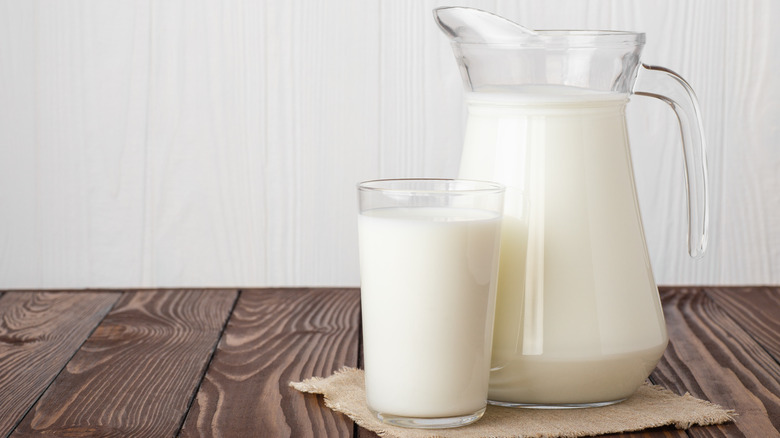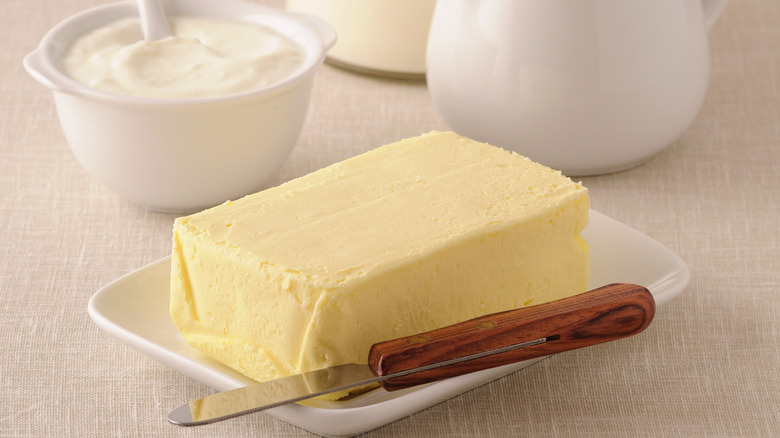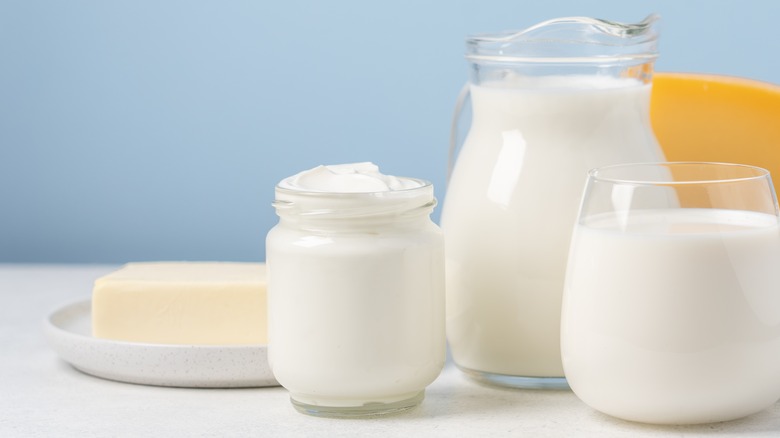The Unexpected Ingredient That Can Transform Milk Into A Heavy Cream Substitute
It's happened to everyone: halfway through a recipe that requires heavy cream, you've either run out or realized you bought the wrong item at the store. Now it's too late to go back and correct your mistake — either because the market is closed or because you're already in progress and leaving now will jeopardize the recipe. Regardless of the reason, you're not going out for more heavy cream. What do you do?
Rather than ordering a pint through Instacart, consider scrounging through your kitchen for creative replacements. For cooking, the important factors to consider are flavor and mouthfeel; for baking, the fat content is generally more important — and as the New York Times' Alexa Weibel showcased on TikTok, one easy way to adjust the fat content is to add butter to milk. In the right proportions, no matter what kind of milk is in your refrigerator, there are several substitutions that can work in a pinch to save your recipe — and help you avoid a trip back to the store.
Add the right amount of butter
First, what is heavy cream, and how is it different from light cream, light whipping cream, or half-and-half? According to FDA standards, in the U.S., heavy cream must have at least 36% milk fat; generally, it has between 36% and 41%. Half-and-half, on the other hand, must be between 10.5% and 18% milk fat; light cream is 18% to 30%; light whipping cream is 30% to 36%. While we're on the subject, skim milk and whole milk are less than 0.5% and more than 3.25% milk fat, respectively. And in case you haven't guessed yet, 1% and 2% milks contain exactly what they claim.
Science and butter can help turn any of these lower-fat dairy products into a reasonable heavy cream substitute to bake or cook with. Depending on your brand of choice, butter will typically have 80% to 84% milk fat. With a little math, it's possible to adjust various kinds of liquid dairy to imitate a cup of heavy cream. With the heavier fat content in light whipping cream, it's an easy substitute of removing 1 tablespoon of cream and replacing it with a tablespoon of melted butter. For half-and-half, it's basically an even swap of a cup of half-and-half plus 2 tablespoons of melted butter. If you have whole milk in the fridge, the ratio changes to a generous ¾ cup of milk and ¼ cup of melted butter, while low-fat milk requires ⅔ cup of milk plus ⅓ cup of melted butter.
Important considerations and other alternatives
You're not going to be able to replicate the homogenization of actual heavy cream at home, but you can get close enough for many applications. June Xie of Delish likes to incorporate the butter and milk with a stand blender or immersion blender, but some good, strong whisking also works.
Should you need them, melted butter substitutes will achieve the best results in dishes served hot like pancakes or penne alla vodka. Because heavy cream stays liquid at room temperature but butter becomes solid, the texture of items like cake and cream scones can change. For a moist crumb, swap the butter for canola or avocado oil. For a dairy-free option, alternative milk and a neutral oil will suffice. In stews and soups, replace the heavy cream with milk and 2 to 3 tablespoons of cornstarch or flour, as Alexa Wiebel does in her TikTok.
If you're out of butter but have Greek yogurt on hand, thin it out with a splash of milk. This can work especially well in recipes with baking soda or baking powder that you want to turn out particularly fluffy, like pancakes or quick breads; the acid in the yogurt will create the chemical reaction that makes the recipe rise.
Finally, remember that the butter and milk solution will not whip like heavy cream. You can make a passable whipped cream from coconut milk; as recommended by Minimalist Baker, you will want to make sure it's thoroughly chilled first.


